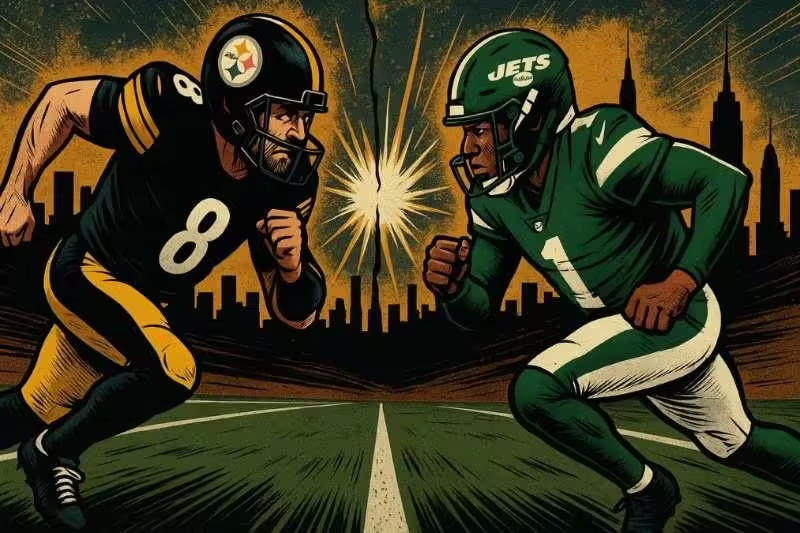The seismic shift reverberating through the NFL isn’t an earthquake; it’s the aftershock of Aaron Rodgers’ signature on a Pittsburgh Steelers contract. The future Hall of Fame quarterback, fresh off a tumultuous Jets divorce, has chosen the black and gold for his potential last dance, signing a one-year, $13.65 million deal (escalating to $19.5M with incentives). This isn’t merely a transaction; it’s a high-stakes cultural reset for a franchise starving for elite quarterback play and a definitive answer to their post-Ben Roethlisberger purgatory.
Why Pittsburgh? Why Now? The Desperation-Meets-Opportunity Calculus
- The QB Wasteland Ends: The Steelers’ quarterback situation since Roethlisberger’s retirement has been historically barren, producing a league-low 46 touchdown passes over the past three seasons. The revolving door of Kenny Pickett, Mitchell Trubisky, Mason Rudolph, Russell Wilson, and Justin Fields yielded playoff appearances but offensive futility, culminating in a late-season collapse in 2024. Rodgers, despite recent struggles, represents a quantum leap in pedigree and potential firepower over Rudolph or a rookie.
- The Win-Now Imperative: With defensive cornerstone T.J. Watt turning 30 and Mike Tomlin’s legendary non-losing season streak (18 years!) perpetually tested, the Steelers’ competitive window relies on immediate contention. Management believes Rodgers, even at 41, offers the highest upside available to catapult them beyond wild-card purgatory and towards a genuine Super Bowl push now. As one executive noted, the alternative options (Wilson, Cousins) offered less ceiling.
- Organizational Alignment & Patience Pays Off: Contrary to public perception of the Steelers being strung along, sources indicate constant communication and mutual understanding existed throughout Rodgers’ deliberation period focused on personal matters. Pittsburgh was prepared to wait, confident in their position, viewing him as the singular target worth their patience. They valued his experience and “best field vision… since Ben,” believing his pre-snap mastery can solve protection issues and unlock an offense lacking answers.
The Realistic Spectrum: MVP Resurgence or Mercenary Malaise?
While Steelers leadership projects optimism, analysts offer a starkly bifurcated view of Rodgers’ potential impact:
- The Upside Case (The 85th Percentile): If Rodgers rediscovers even a fraction of his 2020-2021 MVP form (aided by improved mobility post-Achilles recovery later in 2024), leverages his field vision to mitigate offensive line concerns, and buys into Arthur Smith’s run-centric system featuring DK Metcalf and Jaylen Warren, Pittsburgh possesses the defensive infrastructure (Watt, Fitzpatrick, Highsmith, Porter Jr.) to make a deep playoff run. This outcome was deemed more plausible with Rodgers than alternatives like Wilson.
- The Glaring Concerns & Downside Risk:
- Performance Cliff: Rodgers’ play has demonstrably declined. He ranked 25th in QBR (48.0) in 2024, showed alarming inaccuracy on short/intermediate throws, and has been below average since 2022 (26th in QBR that year) – a trend predating the Achilles tear. Statistical models suggest Mason Rudolph’s recent performance was comparable, if not superior in key metrics like success rate and accuracy.
- Scheme & Personality Clash: Rodgers historically resisted systems not tailored to him. Arthur Smith’s offense relies heavily on play-action and under-center concepts Rodgers dislikes, and demands throws over the middle he’s avoided. The pairing with the physically gifted but route-imprecise DK Metcalf is seen as potentially volatile “oil-and-water”. Will Rodgers buy in, or will friction undermine the offense?
- Age & Durability: At 41, the risk of further physical decline or injury is ever-present. A “2022 Matt Ryan-esque collapse” is a tangible fear among analysts.
Betting Markets & League Perception: Measured Skepticism
The Rodgers signing generated headlines, but oddsmakers delivered a reality check:
- Minimal Super Bowl Odds Shift: DraftKings adjusted Steelers’ odds slightly from +4500 to +4000 (40-1), while BetMGM held firm at 45-1. They remain distant longshots behind AFC elites like Buffalo (+700), Baltimore (+700), and Kansas City (+750).
- Vegas Verdict: “Rodgers has been awful… Rudolph and Rodgers are the same thing for me,” stated Westgate SuperBook VP Ed Salmons, encapsulating the skepticism 6. The move is viewed as an upgrade over Pittsburgh’s recent QB play but insufficient to elevate them into the true contender tier against the conference’s best.
Rodgers’ arrival sets up a season dripping with narrative:
- Week 1: Revenge in Gotham: Rodgers leads the Steelers against the Jets and Justin Fields – his 2024 Pittsburgh successor – on opening night.
- NFC North Reunion Tour: Games against the Vikings (Week 4), Packers at home (Week 8 – Rodgers’ first game vs. Green Bay), Bears (Week 12), and Lions (Week 16) offer relentless storylines.
- AFC North Crucible: The ultimate test. Can Rodgers outperform Lamar Jackson and Joe Burrow twice each? Pittsburgh’s playoff fate likely hinges on divisional performance.
Beyond the Hype: Ripple Effects & The “Bust” Question
- Kirk Cousins in Limbo: Pittsburgh’s commitment to Rodgers slammed the door on a potential Cousins trade, leaving the expensive veteran likely stranded as Michael Penix Jr.’s backup in Atlanta.
- Vikings All-In on McCarthy: Minnesota, linked to Rodgers, instead fully commits to J.J. McCarthy as their starter.
- Fantasy Football Caution: Analysts warn against overvaluing Steelers pass-catchers. Smith’s run-heavy scheme, questions about Metcalf’s fit with Rodgers, and lack of proven WR depth severely cap fantasy upside outside of Metcalf as a volatile WR2 and Jaylen Warren as a potential PPR beneficiary due to Rodgers’ increased check-down tendency in 2024.
- Is it Truly “Super Bowl or Bust”? The Steelers are functionally in this mode. They leveraged patience and a modest financial commitment ($13.65M) for a high-variance QB solution to maximize their defensive window. However, the realistic spectrum of outcomes is broad:
- “Bust” isn’t necessarily missing the Super Bowl; it’s Rodgers replicating his 2024 form, clashing with Smith/Metcalf, and the Steelers finishing 8-9 or 9-8, losing in the wildcard round – wasting a year of Watt’s prime without resolving the long-term QB future.
- “Success” likely means winning a playoff game (breaking the streak dating to 2016) or making a deep AFC Championship run, proving the gamble unlocked their contender status. The Lombardi remains a distant dream, but Rodgers makes it theoretically possible if everything clicks perfectly – the definition of a high-reward swing.
Conclusion: A Calculated, Necessary Risk with Murky Horizons
The Steelers didn’t just sign a quarterback; they ignited a high-octane experiment. Landing Aaron Rodgers is a masterstroke of opportunism, addressing a desperate need with the highest-ceiling option available. It demonstrates a commitment to Tomlin, Watt, and the present. However, it’s a gamble shrouded in legitimate concerns about age, recent performance, schematic fit, and the volatility inherent in a legendary, strong-willed player joining a new ecosystem late in his career. While the “Super Bowl or Bust” mantle might be overly simplistic, the pressure is immense. If Rodgers defies Father Time and seamlessly integrates, Pittsburgh becomes a dangerous dark horse. If the decline is irreversible or friction arises, this Steel City gamble could fizzle, leaving the franchise back at the quarterback drawing board in 2026, having sacrificed another precious year of an elite defense’s prime. The drama, starting Week 1 in New York, promises to be must-see television. The Lombardi Trophy? That remains a steep climb, but for the first time in years, Pittsburgh fans can dare to dream a little bigger.









